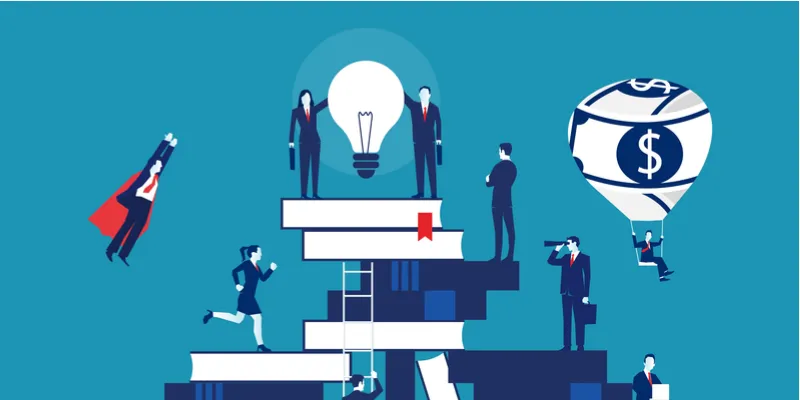Here’s why the give-and-take experience makes crowd learning the way ahead
The collaborative approach of crowd learning helps people gain knowledge on an individual level, nurtures their social skills, and help empower themselves and each other.

Renowned American author, management expert, and consultant Kenneth Blanchard famously said, “None of us is as smart as all of us.” And this holds true since learning together helps people go beyond the concept of unilateral understanding to a give-and-receive learning experience.
Crowd learning facilitates students to reach their full potential, become more creative and productive, inspire and get inspired from, and understand a topic to its very essence rather than just getting a single perspective to a question. While individualised learning, in accordance with the age-old education system and academic curriculum, has always been regarded as a rigid and passive process by students from across the globe, crowd learning is widely appreciated for being insightful and engaging at the same time.
In the last few years, technological advancements have reshaped the way every individual, society, and industry functions. Crowd learning is no exception as its very premise has been leveraged by modern technological tools to establish an effective connection with fellow learners from around the world. Through this approach of collaborative learning, students do not just gain academic knowledge on an individual level but also nurture their social skills and help empower themselves and each other. The highly beneficial method of crowd learning helps one develop holistically. Here’s how:
Development of cognitive skills and creativity
When an individual seeks a solution in a peer-to-peer environment, they tend to get alternate explanations from various perspectives. This does not just enrich their knowledge about a certain topic but also leads to the development of logical reasoning capabilities and broadened perspective. Furthermore, active engagement and discussion of ideas and concepts in a supportive atmosphere result in an increased appetite and curiosity for knowledge. Students also begin to probe deeper, observe, question, analyse, and explore with fellow learners in a crowd learning structure. The variety of solutions to a question asked also lead to recapitulation and better retention.
Moreover, this dynamic environment leads to an increase in productivity as students with varying knowledge collectively brainstorm to seek solutions. Such stimulation of analytical understanding and innovation, together with their peers’ support and insight, makes crowd learning a resourceful facilitator of cognitive skills and creativity.
Enrichment of socio-personal skills
Over the years, crowd learning has proved to be a boon in honing of socio-personal skills. With reduced social interactions and more time spent in interaction with devices rather than people, socio-personal skills are at an all-time low among youngsters. In such a scenario, when individuals from different backgrounds and levels of expertise come together to collectively exchange knowledge, ideas, and experiences, it helps inculcate respect and harmony for diverse cultures. Furthermore, this method serves as an effective platform for developing social skills as students actively interact with each other to seek and suggest solutions and concepts. Such interactions also foster an intrinsic intuition to help, express gratitude, inspire, and be inspired.
There is an increase in one’s awareness of oneself as such a medium allows people to analyse their strengths and weaknesses through internal and interpersonal assessments.
Better self-management
A student may find it tough to keep up with the knowledge imparted when learning in a conventional classroom environment. This is because every individual possesses unique comprehension and grasping capabilities. Crowd learning, therefore, helps develop strong self-management skills as students get to learn according to their pace preference and learning style. Furthermore, by deeming an individual accountable for their own progress in a collaborative environment, this approach also encourages responsibility for learning. Equipped with a substantial knowledge base and utmost support from fellow learners, crowd learning develops confidence in an individual to face challenging situations, academically and otherwise.
An enriching experience
Going beyond the traditional academics-oriented approach, crowd learning provides an authentic and enhanced experience by incorporating real-life skills and values in young minds along with facilitation of learning. Students do not just get to solve problems but get a good grasp over a concept, through insightful inputs from their peers. While they initially come to seek a solution, such a knowledgeable and supportive environment pushes their horizons from questioning to understanding and providing solutions themselves. Students learn to celebrate diversity, express themselves, opinionate, motivate, empathise, mediate disputes, learn from mistakes, be patient, and strive to do better. All this helps in their holistic development, leading to an enriching learning experience that helps immensely in real-life scenarios as well.
Crowd learning: then and now
The method of crowd learning is undoubtedly a traditional practice that students and teachers have been implementing since ages. But technological advancements in recent times, have made crowd learning all the more prevalent and flexible. Supplemented by digital media, it has progressively begun to combine knowledge, skills, processes, experiences, diversity, and technology to evolve into a decentralised and dynamic learner-oriented method.
The formation of online-based crowd learning platforms serves as the strongest example of the rehashed modern approach. These community platforms provide a fertile ground for individuals from diverse backgrounds and having unique skillsets to gather, brainstorm, showcase their talents, and collectively find solutions to an endless array of questions. Since most students at present have been born and brought up in the emerging digital world, they have termed “native speakers” and have completely adapted to this highly efficient online process.
These decentralised aggregating platforms have made information easily available and accessible to all without any knowledge-loss. This is handy since the vast amount of information exchanged in cyberspace often tends to remain among a certain set of people and gets lost amid several similar links.
The emergence of online gaming platforms is also being seen as a trend in the collaborative learning approach. Gaming was, till now, mostly perceived as a competitive activity with negative undertones. But several researchers have found that gaming develops analytical and problem-solving skills, creativity, prolonged attention span, and healthy cooperation in developing and mature minds. As team members strive to get through a certain level together, gaming teaches them to motivate and help each other through different situations and fosters a feeling of togetherness.
Clearly, crowd learning is not just engaging but is also highly beneficial across multiple dimensions. Backed by technological interventions and digital media, it has become one of the most efficient alternative approaches towards holistic development of every learner, and the education system collectively.
(Disclaimer: The views and opinions expressed in this article are those of the author and do not necessarily reflect the views of YourStory.)







